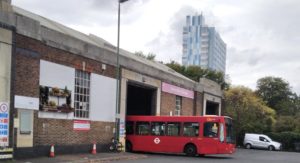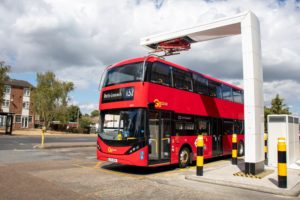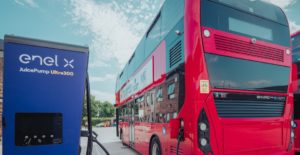
Although requirements vary from depot to depot, the process normally involves a mix of electricity upgrades, new charging facilities and even, in some cases, entirely new depots.
For example, UK Power Networks has enabled more than 500 buses in the capital to turn electric through fast-tracking charging infrastructure work over the last few years.
In a recent nine-month upgrade project, the company made an extra 3.8 megawatts of electricity available to Go-Ahead London’s Sutton Bus Garage, including a new high voltage underground cable along a 1.5km route.
A total of 84 new electric buses are expected to start operating out of the Bushey Road garage site by the end of 2023 to run on routes in south west London.
Louise Cheeseman, Director of Bus at Transport for London (TfL), said: “These works at the Sutton Bus Garage are helping drive forward our zero emission bus agenda, giving bus operators the capacity to charge the significant number of vehicles now operating in London.”
UK Power Networks has also completed work at Arriva Brixton in South West London, to enable new electric buses to charge overnight.
The delivery team installed new cables to provide additional power at the Tramshed garage, which delivers supplies for 22 new electric buses operating on route 319 between Streatham Hill and Sloane Square.
The work has reduced running costs for the bus garage, which is able to charge its new fleet when local electricity demand is very low.
Zenobē, Arriva’s solution provider, installed Hitachi Energy’s Grid-eMotion Fleet system at the site, which dates back to 1892, has limited space and does not support overhead charging infrastructure structurally.
The high-powered charging system is modular and also comes with a compact grid connection, so the system requires up to 60 per cent less space and 40 per cent less cabling than alternative solutions, says Hitachi.
It uses DC charging technology and slimline charging pedestals, each of which charges two vehicles, and the charging capacity is between 50 and 600 kW, depending on the configuration.
All grid connections and charging systems come together in modules and these modules can further be housed either in one cabinet or placed separately and help utilise available space better.
The Grid-eMotion Fleet system is also scalable and enables Arriva to add more columns and modules when it replaces the rest of the fleet with electric buses.
According to Arriva, with a traditional charging solution, it would have lost seven parking spaces and been unable to charge all the vehicles overnight.
Steven Meersman, Zenobē Co-founder and Director, said: “We’re proud to have partnered with Arriva and found solutions to several constraints to electrify the Brixton depot.”
Meanwhile, Pantograph bus charging technology is now providing rapid, high-power top-ups at Go-Ahead London’s Bexleyheath bus garage to power the all-electric route 132 which operates between North Greenwich and Bexleyheath Shopping Centre.
The pantograph is an arm-like structure, that attaches itself to the roof to deliver a quick, high-power charge to buses and it is the first time this technology has been used in London.
Wireless RFID technology is used to allow the bus to communicate with the pantograph.
The buses, which are conventionally charged overnight, receive a high-power current through the pantograph multiple times throughout the day for a power boost, known as ‘opportunity charging’.
Each top-up takes less than ten minutes, allowing buses to travel further each day.
The short top-up time and longer distance each bus can cover means fewer buses are needed to provide the same high level of service
From next year, pantographs will be trialled on the 15-mile route 358 between Crystal Palace and Orpington – one of London’s longest.

John Trayner, Go-Ahead London’s Managing Director said: “Route 132 is the latest in a long line of pioneering zero emission firsts for Go-Ahead London.
“Working innovatively with our supply chain, we have extended vehicle range by harnessing technology, in the process reducing the overall number of buses required to provide service and delivering significant cost savings.”
Also, Enel X UK has completed the charging infrastructure works at a new bus depot in Hayes, for operator Abellio London Bus.
The facility currently hosts an initial 12 e-buses, which incorporate 382kWh batteries that can be fully charged in just over three hours, and the site can be expanded to accommodate a fleet of up to 56.
Enel X’s e-bus team was responsible for enabling the depot’s electrical infrastructure, as well as installing a low voltage switch panel and switch gear that now powers six 300kW Enel X Way charging stations.
These stations run on Enel X Way software that is able to optimise charging schedules based on site load, energy costs, and bus timetables.
Enel X will also maintain and service the stations for the next 14 years with the option to increase charging capacity.
Delivery of works at the Hayes depot is the first of three projects that Abellio has awarded to Enel X in the Greater London area with further e-bus infrastructure due at facilities in Battersea and Beddington.

“Enel X have supported us at our Hayes depot to operate state-of-the-art buses that are providing more comfortable, accessible journeys to passengers and contributing to the decarbonisation of the network in London.”
TfL has committed to deliver a fully zero emission bus fleet by 2034, as outlined in its Bus Action Plan.
One thing that’s for certain is the installation of charging infrastructure across London is due to intensify over the coming years, as zero emission buses become the norm on routes all across the capital.








